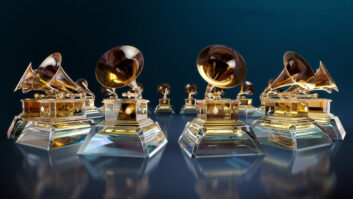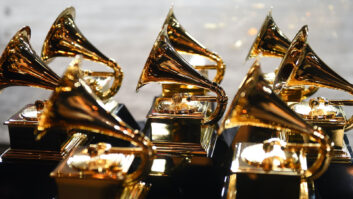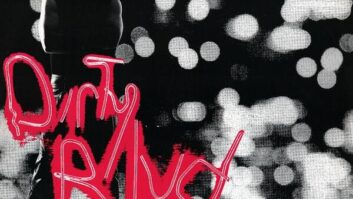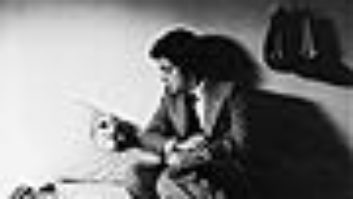To hear Jeffrey Lesser tell it, he’s not really working. Despite a successful engineering and producing career that spans nearly four decades, he continues to explore his love of music with almost childlike enthusiasm. Somehow, that seems appropriate for a man who, from his earliest days at Mediasound Studios (New York City), cut his engineering teeth on Sesame Street episodes. From that era to the present, in his new incarnation as music supervisor and producer for yet another new children’s television show based in New York, Lesser has a reservoir of experience to draw from that is as wide as it is deep. His credits include recordings for the likes of Kool & The Gang, Barbra Streisand, Lou Reed, multiple Grammy-winning Irish group The Chieftains, the Oscar- and Grammy-winning film soundtrack for The Lord of the Rings: The Return of the King and the Tony Award — winning original cast album Parade. He’s also produced discs by The Strawbs, Loudon Wainwright III, The Roches, Pat Travers — even jam band Donna the Buffalo. Yet, somehow for him, work is still play.
When Lesser called to tell me he had taken a position with Little Airplane Productions (www.littleairplane.com), producing music for the first 40 episodes of a new series entitled The Wonder Pets!, I was delighted. The show is the latest brainchild of Josh Selig, creator and executive producer of the current hit show Oobi and winner of 10 Emmy Awards for his work as a writer on Sesame Street. As Lesser and I both began our careers at Sesame Street and Selig was a child actor on the series, I couldn’t help but feel that the confluence of serendipity demanded further investigation.
Lesser invited me down to Clinton Studios to observe a scoring session first-hand, and to see the changes that have taken place in children’s television over three-and-a-half decades. Our conversation then moved to his home, where he shared his passion for his new show and some older memories.
The scoring session I attended for The Wonder Pets! was crackling with energy. Tell me about the creative team you have working on this project.
It’s an amazing collection of artists, animators and digital layout people, all under the roof of the creator of the show, Josh Selig, who came up with the concept of The Wonder Pets! We have a group of well over 50 people coordinating their energies toward this show, which will air [in the spring] on Nickelodeon. One thing that is very unusual for just about any show these days, but certainly for children’s television, is that we use a live orchestra. It’s sort of a mini opera, and one of the mainstays of each episode is that the characters travel to other lands, delving into the music of the locals.
You have a wealth of experience in world music.
Yes. I think I’ve done seven or eight albums with The Chieftains, and in the course of doing them, besides working in Ireland and in the United States, we’ve traveled all over. They specialize in using guest artists on their albums. Sinéad O’Connor was the first, which we did in the same studio here at Clinton, where we’re recording The Wonder Pets!
Was it your experience with The Chieftains that led you back to Ed Rak’s studio?
That was definitely part of it. Parade was done here, The Rocky Horror Show, tick, tick…Boom! — a bunch of wonderful projects that I did with Ed. He’s got great ears, and the room is fantastic. Even though we’re all digital and in Pro Tools these days, I go back to the days before digital was even a word in audio. Ed’s got a beautiful vintage Neve 8078 board, with an amazing collection of tube microphones. And the sound of the room itself — all of this adds to a kind of warmth that we maintain right to the end product.
You’re recording through antique Class-A electronics. Once you enter the digital domain, do you remain there?
Yes. We set up a studio at Little Airplane. We actually do the entire recording there, except for the orchestra — all the mixing, voice-overs, editing and even all the final digital laybacks. I have a wonderful right-hand man, Steven Rebollido, who has progressed from assistant to audio associate producer and whom I feel very lucky to have. We have our own video editors and video-editing suite in-house at Little Airplane Productions, as well.
One of the reasons we stay in the digital domain is that we’re always floating between 12 to 15 shows at the same time. From the earliest stages, in dealing with the composers all the way through recording the voices to MIDI, doing scratch music tracks and then, finally, the live orchestra, mixing and editing, I may have to jump between four or five shows in a single day. So when I’m in the Pro Tools environment, I can instantly open up right where I left off.
You don’t have to wait for the tape to rewind anymore!
I remember the old days of recalls, where you had Polaroid pictures and you were talking into a tape recorder. But one [good] thing about rewinding was that it gave you a 30-second break!
Though the pace of your session is really brisk, you still rigidly adhere to all the traditional breaks.
All the breaks, limits and overtime requirements I learned from doing cast albums. I worked with an artist named Jason Robert Brown, who wrote a show called Songs for a New World that played off-Broadway. Very shortly after that, he got a call from Hal Prince to write the music for Parade, which was “on Broadway.” There’s something very different about actors when they’re in the studio, as opposed to singers and musicians. First of all, they’re so grateful to be there. And they love to perform. The experience of recording a live Broadway cast album is very intense.
What about time constraints?
There are union time constraints and budget constraints. Because of AFTRA and the AF of M contracts, you really have to get it done in one mammoth day. And that’s how most of them are done.
So those sessions were really good preparation for the kind of sessions you’ve been doing in TV.
Totally. Generally, you’re recording a cast album after they’ve performed the show many, many times, so they come in well-rehearsed. And there’s something very stimulating to an actor when he knows that this is the performance that’s going to be preserved for posterity.
Engineer Ed Rak (L) and Jeffrey Lesser at Clinton Studios (New York City), recording The Wonder Pets! orchestra
You mentioned that The Wonder Pets! format is comparable to a mini-opera, in that most of the dialog is sung or spoken to a music track. That’s an awful lot of music to do for 40 shows!
Each show is 12-and-a-half minutes. There are two episodes per half-hour show. The first minute is an intro before the new music kicks in, but once it does, it’s non-stop for approximately 10-and-a-half minutes, seamlessly going from underscore to songs to recitatives. We use kids in all the parts. The only adults we use are in the reunion at the end of each episode where the mama or the papa gets together with the animal that’s been rescued by the Wonder Pets. The Wonder Pets and all their animal friends are played by brilliant, brilliant kids.
The character voices are recorded first — to piano only — for each show’s segment, which is quite the opposite of what was done back in the ’70s on the Sesame Street shows that you and I worked on. There, the voices were done last. Why is the process reversed for this show?
Partly for the animation technique. We template the entire show in real time, with real tempos in the real keys, and then they lip-sync the animated characters to our final takes. The composer delivers to us a first pass of the music, with his voice doing all the voices to piano. Then we strip out the composer’s voice and add the kids. They lip-sync picture to our final production vocals.
Before we go in and record the orchestra, we do a MIDI mockup. But we don’t use it in the final rendering. It’s all replaced with a real orchestra. Occasionally, there’s a little bit of MIDI orchestra enhancement mixed in.
I noticed that you record the orchestra in short bursts of four or five bars at a time, punching in on Pro Tools until the entire score is done perfectly. Then you record a complete performance for feel without stopping for mistakes.
It’s called making sure you have what you need for the takes! [Laughs] We’re not really punching in; we’re doing separate takes. We’ll take it as far as we can. We start off with one complete read-through…
You playlist it?
Right. We do a first run-through — which is pretty much non-stop — to sort out whether the copyist got all the notes right or whether there are any changes we have to make. Sometimes the music is composed before final animation. Then, seeing the animation at the session, sometimes we have to doctor little moments. The arrangements are fairly complex, and it’s tough to grab in one long take, so I do it in pieces, making sure all the pieces are accurately played with a good feel. In the end, when I’m sure I have everything I need, we do one more complete take, because, oftentimes, that has the best feel. If it’s a balance between perfection and great feel, I’ll always lean toward feel and groove.
Do you use any outboard gear when you mix?
No, I use virtual plug-ins.
Do you use virtual bus compression?
Yes.
How does your overall bus compression differ for television from the kind of compression you use for records?
Every soundtrack that goes to TV is scrutinized by the networks for quality control. Certainly for pops and clicks and distortion, but for level, too. There is a brickwall limit that we cannot go beyond. If we do go beyond it, it gets sent back. So in that regard, it’s very different.
What microphones do you depend on?
We use Neumann mics, of course, wonderful old Telefunken 251s, some ribbon mics — Coles; a wide assortment.
You cut your engineering teeth at Mediasound. What led you there?
Before Media, I was a film editor and a film soundman. I worked with Brian DePalma on a film starring Robert DeNiro [Greetings, 1968]. Mediasound had just opened their doors. They were doing a lot of jingles and movie soundtracks, and some pop stuff, but they needed someone who had experience in film, so Harry Hirsch [co-owner and founder of Mediasound] brought me in as their film specialist.
Who do you consider your greatest mentor or influence from those early days?
The late Joe Jorgensen had a really profound influence on me, as did Fred Christie. Tony Bongiovi was amazing. He said, “Don’t look at the meters.” As a matter of fact, when I was doing a session with him, he’d put a piece of paper over the meters so that I could learn where the sounds and levels needed to be by listening instead of staring at meters. He said in his unique voice [imitates], “The only thing you have to worry about, Jeffrey, is if the needle is all the way to the left or all the way to the right. As long as it’s moving, you’re in good shape!” [Laughs] I loved that and kept that advice for years. Of course, I had to be a little more careful once I started working in the digital domain.
From left: Jeffrey Lesser, Barbra Streisand and Rupert Holmes during the recording of Streisand’s Lazy Afternoon
It was right about the time you were recording Kool & The Gang at Media that you met your first partner, Rupert Holmes.
Yes. I believe it was Susan Planer [the general manager of Mediasound] who thought we would be a good pair. Rupert was doing one of his songs under a group name — a lot of people did that in those days — and we hit it off instantly. Rupert was brilliant in terms of writing lyrics and arrangements, but also incredibly flexible and open to outside ideas.
We were both pretty green at that time. I was greener than he was, but there was a wonderful give and take in the relationship. We used a live orchestra on his album Widescreen (1974). It was great. And Rupert was good with deadlines. If you needed him to finish a chart, you could book the studio time, and if he knew we were recording on Thursday at 10 o’clock, he would have those charts finished in plenty of time — like by 9:30 Thursday morning [Laughs]! I swear, if we had two songs to record, he’d be scribbling out the last few notes for the second one while we were still recording the first!
Paddy Maloney, like Rupert Holmes, is an arranger par excellence.
Absolutely. He’s really the brain behind The Chieftains.
Did you concentrate on the recording aspects of The Chieftains’ albums as opposed to the arrangements, or was it a combination of both?
I had very little to do with the arrangements. When I work with The Chieftains, Paddy Maloney is the producer. He is the one who handles the choosing of the material, and he pretty much runs the sessions. Many of the artists who we worked with — from Joni Mitchell to Linda Ronstadt, Sting, Sinéad O’Connor, Diana Krall, Lyle Lovett — many of them met The Chieftains at the session, so that they would walk in, at least on several albums that we did, and we would devote a day to each artist. And the day would comprise them coming in, learning the song and — by 12, 1 or 2 o’clock — start recording and by 3 or 4 o’clock have an amazing take in the can.
Most album productions are partnerships. There’s a trust the band places in a producer/engineer to get them to something that really represents them. How do you view the role of producer?
There are many, many different types of producers. I have always been fully collaborative with the artists I work with. The artists get their name in the big letters. Their input is always important. Sometimes they may need to be pushed a bit, but it’s a liquid process. Making an artist comfortable in the studio is absolutely essential, as well as getting takes fairly quickly. If you get a final vocal early in the process, everything will be triggered off that performance. I’ve always drawn the parallel to a painting hanging in a museum. If the frame pulls your eye away from the painting, it’s the wrong frame for that painting. The song and the artist’s personality are the painting.
The record and the music create the frame. Anything that stands in the way of seeing the artist or the story the songwriter is telling is a distraction. It’s sometimes difficult to capture a great performance. Artists are not always ready to get the final vocal. I try to get into the artist’s head to find out what they need. [That’s] better than being dictatorial. I know some artists may need that, and they can go ahead and work with producers who are like that! But, hey, it’s a big family, this music business, and a big world. There’s someone for everyone!
What’s your favorite mic for vocals?
The Telefunken 251.
What’s your favorite mixing console?
I’m mixing in the box in Pro Tools. I’m using a Digidesign Control 24, and you do get the feel of a fader. Even though it is a data controller, it looks and feels like a console.
How have the changes in recording technology made life easier for you as a producer?
Well, the recall thing I can’t stress enough. To be able to leave something that is 50 percent done, jump to something else, then go back and have things be exactly where they were when you left off is wonderful.
There are things that I miss about mixing in real time. We marked every fader with grease pencils and tape, and more often than not, if you didn’t have enough hands, your assistant engineer or possibly one of the musicians would be on a fader — so at times, there could be up to five people hovering over the board, each with a little move, knowing that at the first chorus, their fader would have to go from minus eight to minus four or whatever. And there was that moment at the end of the mix when you pulled down the master fader and everyone would yell, “We got it! We nailed that one!” You don’t have that now. You finish and go, “Well, that was good. Did we lose the hi-hat in the middle of that bridge? Do you think we need a little more reverb on that one tom hit?”
There’s more emphasis on perfection over feel than there was in those days?
I think so. And you have to watch yourself to make sure that you don’t lose the feel by tweaking too much. You can make something as perfect as you want. You can retune, retime…
If you had to advise young kids who are starting out, is that one of the things you would steer them toward — relying more on feel than perfection?
Without a doubt! You can abuse a feel, too, by doing too many takes. I would say that preparing in advance before you go in to record [helps]. If you beat a song to death, you get to the law of diminishing returns, where the song is getting perfect and feel is going down the drain.
Michael Barbiero is a producer/engineer/mixer with credits on a slew of albums by top artists, including Ziggy Marley, Metallica, Guns N’ Roses, Gov’t Mule, Maroon 5, Counting Crows, Blues Traveler and many others.
Selected Discography
P, producer; E, engineer; M, mixer
Barbra Streisand:
Lazy Afternoon (1975, P/E/M)
Rupert Holmes:
Widescreen (1974, P/E/M)
Lou Reed:
New York (1989, E/M)
Kool & The Gang:
Jungle Boogie (1973, E/M), Funky Stuff (1973, E/M), Hollywood Swinging (1973, E/M)
The Chieftains:
Long Black Veil (1995, E/M), Santiago (1996, E/M)
The Lord of the Rings: The Return of the King (2003, E/M)
The Rocky Horror Show (2001, P)





